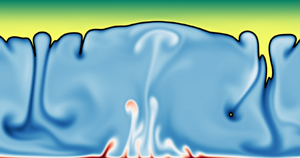Article contents
Turbulent convection in subglacial lakes
Published online by Cambridge University Press: 11 March 2021
Abstract

Subglacial lakes are isolated, low-temperature and high-pressure water environments hidden under ice sheets. Here, we use two-dimensional direct numerical simulations in order to investigate the characteristic temperature fluctuations and velocities in freshwater subglacial lakes as functions of the ice overburden pressure,  $p_i$, the water depth,
$p_i$, the water depth,  $h$, and the geothermal flux,
$h$, and the geothermal flux,  $F$. Geothermal heating is the unique forcing mechanism as we consider a flat ice–water interface. Subglacial lakes are fully convective when
$F$. Geothermal heating is the unique forcing mechanism as we consider a flat ice–water interface. Subglacial lakes are fully convective when  $p_i$ is larger than the critical pressure
$p_i$ is larger than the critical pressure  $p_*\approx 2848$ dbar, but self-organize into a lower convective bulk and an upper stably stratified layer when
$p_*\approx 2848$ dbar, but self-organize into a lower convective bulk and an upper stably stratified layer when  $p_i < p_*$, because of the existence at low pressure of a density maximum at temperature
$p_i < p_*$, because of the existence at low pressure of a density maximum at temperature  $T_d$ greater than the freezing temperature
$T_d$ greater than the freezing temperature  $T_f$. For both high and low
$T_f$. For both high and low  $p_i$, we demonstrate that the Nusselt number,
$p_i$, we demonstrate that the Nusselt number,  $Nu$, and Reynolds number,
$Nu$, and Reynolds number,  $Re$, satisfy classical scaling laws provided that an effective Rayleigh number
$Re$, satisfy classical scaling laws provided that an effective Rayleigh number  $Ra_{eff}$ is considered. We show that the convective and stably stratified layers at low pressure are dynamically decoupled at leading order because plume penetration is weak and induces limited entrainment of the stable fluid. From the empirical equation for
$Ra_{eff}$ is considered. We show that the convective and stably stratified layers at low pressure are dynamically decoupled at leading order because plume penetration is weak and induces limited entrainment of the stable fluid. From the empirical equation for  $Nu$ with
$Nu$ with  $Ra_{eff}$, we derive two sets of closed-form expressions for several variables of interest, including the unknown bottom temperature, in terms of the problem parameters
$Ra_{eff}$, we derive two sets of closed-form expressions for several variables of interest, including the unknown bottom temperature, in terms of the problem parameters  $p_i$,
$p_i$,  $h$ and
$h$ and  $F$. The two predictions correspond to two limiting regimes obtained when the effective thermal expansion coefficient is either approximately constant or linearly proportional to the temperature difference driving the convection.
$F$. The two predictions correspond to two limiting regimes obtained when the effective thermal expansion coefficient is either approximately constant or linearly proportional to the temperature difference driving the convection.
Information
- Type
- JFM Papers
- Information
- Copyright
- © The Author(s), 2021. Published by Cambridge University Press
References
REFERENCES
- 14
- Cited by


